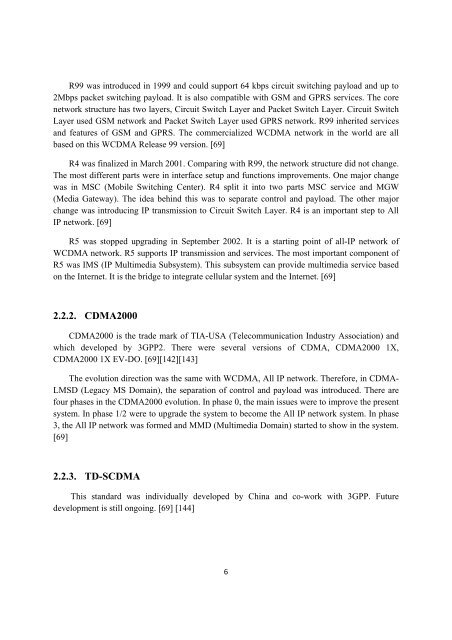A comparison of wi-fi and wimax with case studies - Florida State ...
A comparison of wi-fi and wimax with case studies - Florida State ...
A comparison of wi-fi and wimax with case studies - Florida State ...
Create successful ePaper yourself
Turn your PDF publications into a flip-book with our unique Google optimized e-Paper software.
R99 was introduced in 1999 <strong>and</strong> could support 64 kbps circuit s<strong>wi</strong>tching payload <strong>and</strong> up to<br />
2Mbps packet s<strong>wi</strong>tching payload. It is also compatible <strong>wi</strong>th GSM <strong>and</strong> GPRS services. The core<br />
network structure has two layers, Circuit S<strong>wi</strong>tch Layer <strong>and</strong> Packet S<strong>wi</strong>tch Layer. Circuit S<strong>wi</strong>tch<br />
Layer used GSM network <strong>and</strong> Packet S<strong>wi</strong>tch Layer used GPRS network. R99 inherited services<br />
<strong>and</strong> features <strong>of</strong> GSM <strong>and</strong> GPRS. The commercialized WCDMA network in the world are all<br />
based on this WCDMA Release 99 version. [69]<br />
R4 was <strong>fi</strong>nalized in March 2001. Comparing <strong>wi</strong>th R99, the network structure did not change.<br />
The most different parts were in interface setup <strong>and</strong> functions improvements. One major change<br />
was in MSC (Mobile S<strong>wi</strong>tching Center). R4 split it into two parts MSC service <strong>and</strong> MGW<br />
(Media Gateway). The idea behind this was to separate control <strong>and</strong> payload. The other major<br />
change was introducing IP transmission to Circuit S<strong>wi</strong>tch Layer. R4 is an important step to All<br />
IP network. [69]<br />
R5 was stopped upgrading in September 2002. It is a starting point <strong>of</strong> all-IP network <strong>of</strong><br />
WCDMA network. R5 supports IP transmission <strong>and</strong> services. The most important component <strong>of</strong><br />
R5 was IMS (IP Multimedia Subsystem). This subsystem can provide multimedia service based<br />
on the Internet. It is the bridge to integrate cellular system <strong>and</strong> the Internet. [69]<br />
2.2.2. CDMA2000<br />
CDMA2000 is the trade mark <strong>of</strong> TIA-USA (Telecommunication Industry Association) <strong>and</strong><br />
which developed by 3GPP2. There were several versions <strong>of</strong> CDMA, CDMA2000 1X,<br />
CDMA2000 1X EV-DO. [69][142][143]<br />
The evolution direction was the same <strong>wi</strong>th WCDMA, All IP network. Therefore, in CDMA-<br />
LMSD (Legacy MS Domain), the separation <strong>of</strong> control <strong>and</strong> payload was introduced. There are<br />
four phases in the CDMA2000 evolution. In phase 0, the main issues were to improve the present<br />
system. In phase 1/2 were to upgrade the system to become the All IP network system. In phase<br />
3, the All IP network was formed <strong>and</strong> MMD (Multimedia Domain) started to show in the system.<br />
[69]<br />
2.2.3. TD-SCDMA<br />
This st<strong>and</strong>ard was individually developed by China <strong>and</strong> co-work <strong>wi</strong>th 3GPP. Future<br />
development is still ongoing. [69] [144]<br />
6
















